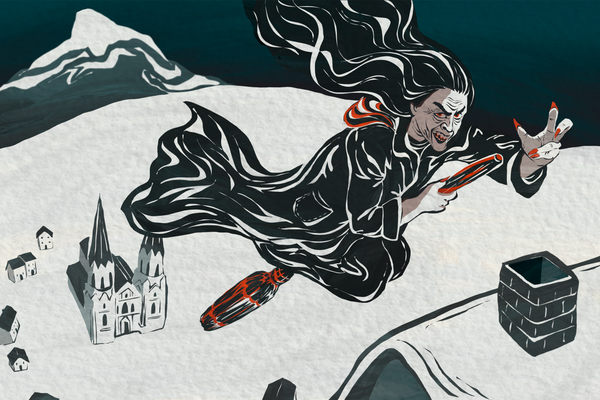Meet Turoń, Poland’s Dancing Bull-Beast of Winter
The ancient tradition of Turoń bestowing blessings has faded but, like the creature itself, it may be resurrected.
Travel back a century or so, to a chilly winter night. Christmas has come and gone, and New Year’s Eve is on the horizon when a group of carolers approach your door. They’re dressed as figures from the Nativity. Elated, you welcome them. Then you notice a terrifying stranger among them: a tall creature with musky-smelling hair, silver bull horns, and a snapping jaw pierced with nails. He dances and jumps to the music, sometimes pouncing on children.
Meet Turoń, a symbol of virility. Polish Academy of Sciences folklorist Ewa Masłowska says the figure’s name derives from tur, the Polish word for aurochs, an ancient bovine that roamed much of Eurasia but was hunted to extinction by the 17th century. Turoń was one of the traditional characters portrayed by mummers who wandered and danced through the streets of Poland from Christmas through Lent. Unlike other European winter creatures, such as Père Fouettard and Krampus, Turoń does not dole out punishment. Instead, says Masłowska, this hirsute representative of ideal manhood brings blessings of fertility, including a good harvest for the year ahead.
Performing as Turoń descended from a millennia-old pre-Christian Polish tradition, when men dressed as aurochs and danced in rituals intended to bring fertility to their communities and farmland. The modern Turoń entered each home to chase people, particularly children, and dance frantically to the music. He then collapsed into a lifeless heap on the floor, only to be “reborn” when the carolers or hosts provided him with a small sip of vodka. After drinking it, he sprang to life again. According to Masłowska’s research, this ritual of life, death, and rebirth echoes another ancient pagan tradition in Poland: symbolizing the lunar cycle of waxing and waning through different animals, which in turn also represent ritual rites of passage for humans. In the tradition, the impressive horns of the aurochs are a symbol of the crescent moon.
The tur—and, by extension, Turoń—is primarily associated with fertility, strength, and masculinity. Even today in Poland, the phrase silny jak tur, or strong as an aurochs, conveys power and sexual prowess in a man.

However, it turns out that even the virile Turoń needs protection. Turoń behaves aggressively, and the costumes are particularly fearsome, the mummer’s face completely hidden, to fool evil spirits that might also have been out and about on the cold winter night.
“The mask was to protect against the devil, against evil. If they are in the mask, it means that they are strangers,” Masłowska says. “The evil is also a stranger, so the evil will not disturb [Turoń, thinking it is one of their own].”
Turoń’s terrifying appearance, and tendency to chase children, allows the figure essentially to blend in with malevolent creatures so that they leave him alone, letting him stealthily deliver blessings to the community.
The tradition of Turoń coming to your door around Christmas more or less died out in the 20th century, though mummers dressed as aurochs were sometimes spotted in the days leading up to Ash Wednesday and other times of year.
However, much like the revival of Krampus, now a global phenomenon, the Germanic Frau Perchta, and the shaggy kukeri of Bulgaria, Turoń is making a bit of a comeback. While the blessing bull figure is likely enjoying more attention as part of a pop culture trend celebrating the darker characters of winter holidays, there’s something else behind renewed interest in the tradition. Some practitioners of Rodnovery, a modern interpretation of pre-Christian Slavic beliefs, are reviving the ancient pagan fertility ritual of stado, which involved men dressed as aurochs, and bringing the dancing bull back to Polish streets.
So if a tall creature resembling a bull shows up at your door, don’t dismiss him out of hand. Just have the vodka ready.

















Follow us on Twitter to get the latest on the world's hidden wonders.
Like us on Facebook to get the latest on the world's hidden wonders.
Follow us on Twitter Like us on Facebook